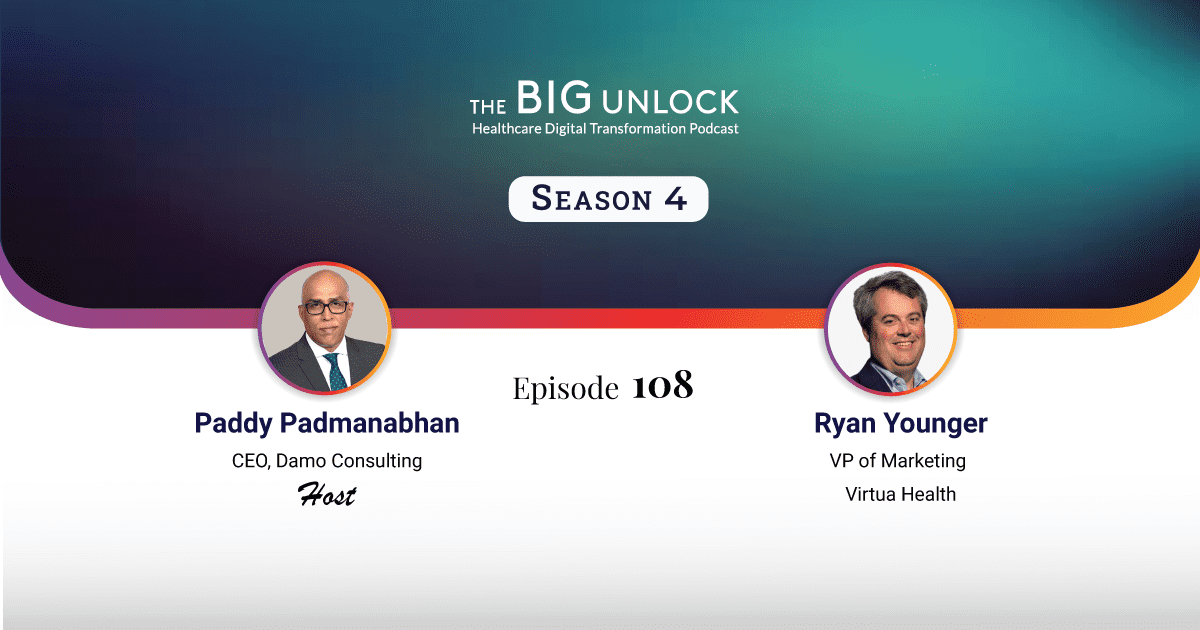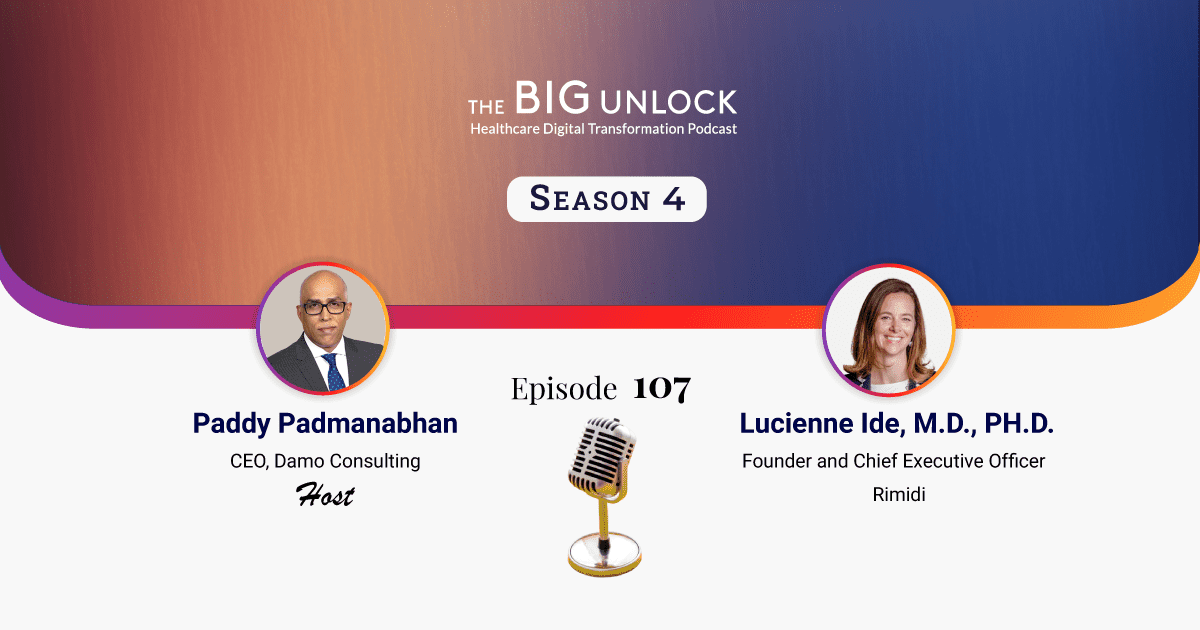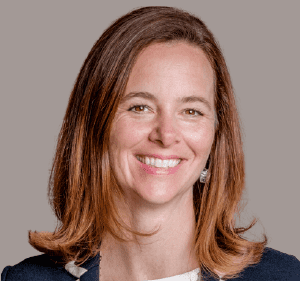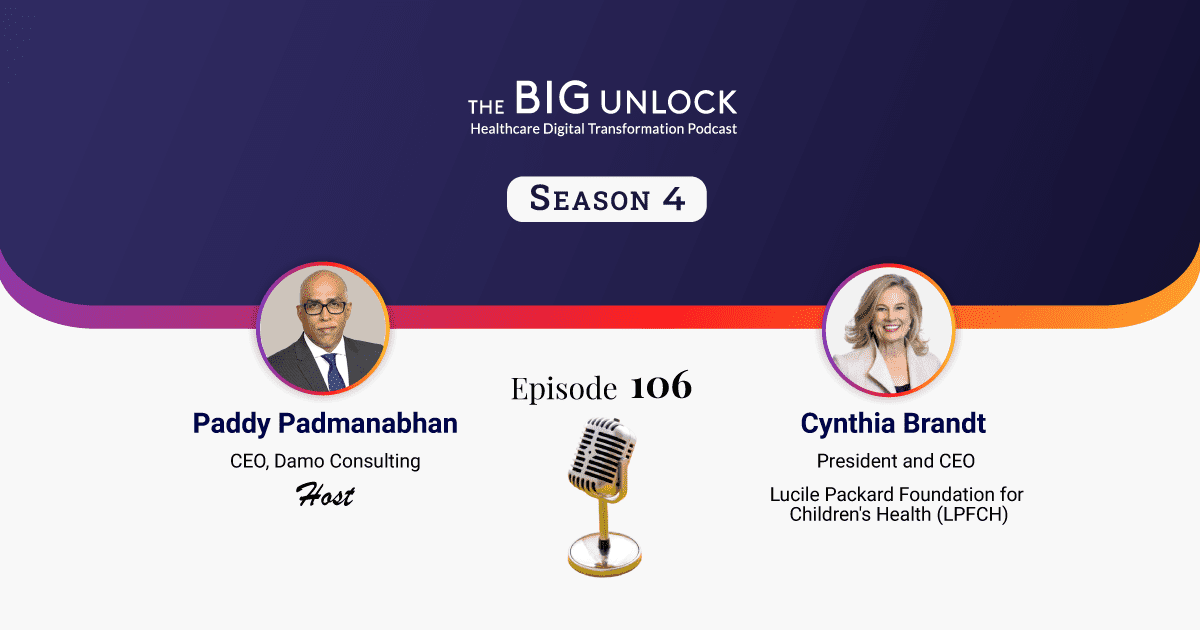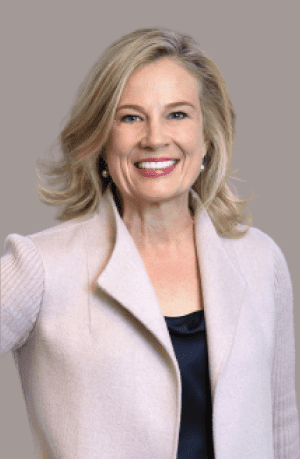Season 4: Episode #108
Podcast with Ryan Younger, VP of Marketing, Virtua Health
"Digital health must leverage AI, chatbot, and data analytics technologies to understand patient propensities."
 Hosted by Paddy Padmanabhan
Hosted by Paddy Padmanabhan 
Share
In this podcast, Ryan Younger, VP of Marketing at Virtua Health, discusses the consumer-driven era of healthcare, emerging digital health technologies, and why active listening to the consumers at every phase is crucial. Virtua is a leading New Jersey-based not-for-profit healthcare system that operates a network of hospitals, surgery centers, and physician practices.
Digital health tools like AI, chatbots, and leveraging data and analytics capabilities assist clinical leaders in understanding patients’ propensity. Ryan identifies insights in business, identifies channels for growth, and indicates why marketing will always be a critical organizational function that binds people and drives digital engagement. Take a listen.
Show Notes |
||||
| 01:13 | Tell us about Virtua Health, your role, and the digital transformation journey. | |||
| 02:26 | How has your role evolved since the pandemic, and what are your priorities for 2022? | |||
| 03:57 | How is Virtua Health addressing the changing expectations in a consumer-driven era of healthcare? | |||
| 05:57 | How do you research these preferences? Can you talk about some of the things you’ve done to look at what your patient populations are specifically looking for? | |||
| 09:37 | Can you share one or two nuggets of insights that you've gained over the last year, which is driving your marketing programs? | |||
| 13:16 | How are you deploying CRM and where does it fit in your digital engagement goals? | |||
| 14:52 | How do you leverage the data? How do you make the connection from an infrastructure and data analytics standpoint to drive this service line strategy? | |||
| 16:30 | What are the two to three things you see across healthcare that they're all focused on? What will be the big themes in 2022? | |||
| 18:16 | There are so many non-traditional players in the health care services space now. What do you think really differentiates a traditional health system like yours in the eyes of your target population? | |||
| 19:50 | How can your peers raise their profile or visibility and highlight its importance in the digital era? | |||
| 21:19 | What are the important technologies that you think will drive the marketing function in the future? | |||
About our guest
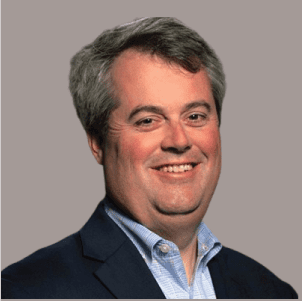
Ryan Younger, VP of Marketing at Virtua Health has worked in health care for three well-known organizations. He has been a frequent speaker on driving revenue growth strategies, connecting marketing technology, consumer insights and brand. Currently, he is vice president of marketing at Virtua Health, the leading health system in southern New Jersey.
Q: Ryan, tell us about Virtua Health, your role there and the digital transformation journey.
Ryan: We’re a medium-sized health system in southern New Jersey with about 300 locations including the hospitals, ambulatory surgical centers, and urgent-care physician offices. Our mission is to help people be well, get well, and stay well.
Q: Tell us what your role as VP-Marketing, entails.
Ryan: My role entails a little bit of everything within the team – from managing the brand, creative strategy, analytics, digital to a plethora of areas across the organization where I work with people on experience, recruitment, philanthropy and support both, operations and the clinical aspect. It’s expansive and keeps me going.
Q: Quite the comprehensive role but how has it evolved since the pandemic and what are your priorities for 2022?
Ryan: Some of the changes that are on the horizon or have happened during the pandemic were certainly there, before. People have spoken about how much these got accelerated. Virtua Health’s always played a critical role in intra-organization communications with research and insights, creative strategy, and content development. We continue to grow in influence in terms of how much the organization is counting now on strategy, digital health, change management, peoples’ experiences, and how we can influence it.
This year too, we hope to extend our influence across areas — digital transformation, building that brand and content strategy. Since the past three years that I’ve been at Virtua, one of our three strategic goals has been orienting to the consumer and that’s driven us. That will continue into 2022.
Q: Healthcare has never been really known as a consumer-focused industry up until relatively recently. So, how is Virtua Health addressing these changing expectations in a consumer-driven era of healthcare?
Ryan: It stems from the leadership understanding that to succeed we must be close to the consumer. That is one of our three organizational goals, and it helps us address changing expectations. With regard to expectations, some of that has to do with generations — new generations accessing more healthcare.
If we think about the millennials, the oldest there have hit age 40 now, and they have families, are homeowners as well, so we can’t use that term to imply they’re young people. They want things when they want it, and they certainly have considerable resources at their fingertips, so, they’re empowered, and the expectation is they’ll influence decision-making. They might not go through a primary care physician for all their healthcare. Instead, they may switch to an app or a digital mechanism or urgent care. So that consumer push has been here for a while with people looking for convenience and access and just different expectations around greater value being assigned to time. We’re all busy people, not just the doctors and that influences many areas.
Q: How do you research these preferences? Can you talk about some of the things you’ve done to look at what your patient populations are specifically looking for?
Ryan: I’m glad you mentioned that because it’s definitely all ages that research their options. Our seniors are more tech savvy than they’re given credit for. As for our strategies for research, we just actively listen to our consumers at every phase. We’ve also built a Community Insights Panel, which now comprises over 30,000 people and that’s where we ask them about preferences, how they feel about different services we offer or how they make decisions, and what’s important to them. We tap that group a lot as well.
Q: You have the panel offering feedback, then you action that via some digital health program which is a way to meet the patient where they want to be met. Since these days, it’s all online, how do you pull a program like this together within an organization? How do you bring together the Infrastructure, IT, contact centre, marketing, partners to align and serve patients’ needs?
Ryan: All these areas you’ve mentioned are important. We try to be that voice of the customer and talk about what we’re hearing, seeing, and what our customers are telling us. So, whether that’s patients to clinicians, employees to HR, or customers to the access center, we try to bring that message forward and remove some of our subjectivity. If all of us align along a particular goal, we’ll talk about testing what works – this creative or that or whether this message resonates more than the other. We put that right into the field – an email, a digital ad – and check what gets people to the action that we want and just maximize from there. That’s an effective way of aligning people with one goal — when you put the needs of the customer first, and make it about the data, that’s what gets us there.
Q: Can you share one or two nuggets of insights that you’ve gained over the last year, which is driving your marketing programs, perhaps something that came to you as a surprise?
Ryan: Sure, I’ll mention two. Everyone knows a lot about the pandemic and the long-haulers or people with long-haul symptoms. We were trying to launch a service around the long-haul effects that people were having. We wanted to see if people understood what it would do, how they’d access it, what’d make it valuable to them.
We’ve learned this in some other areas that language makes a difference. People don’t want to be identified by their disease if they’re long-haulers, and that became very clear. So, when we launched the service, we called it Care After COVID, which was just another way of looking at it. It’s descriptive enough so people didn’t wonder what it was. It looked at things a little differently and that’s an example of something where we asked people and figured out what would work best.
Another instance would be just how we learn about behaviour. We all know this intuitively, but one thing that we were able to test in our CRM system was how to get people to move towards action? If we could understand the health services they might need, how do we connect them to those? What we wanted to learn was how many rounds of communication it’d take? So, we always got the best and the largest number of people to act upon the first time we reached out. We talked about the power of the nudge – where if you talk to people that second, third, fourth time, they’d be four times more likely to use the service intended for them. While we weren’t surprised that we needed to do that, we learned a lot about the number and the type of communications to be used.
Q: You mentioned CRM. Many health systems are investing in it now and there’s so much you can do with it. How are you deploying CRM technology and where does it fit in your digital health engagement goals?
Ryan: One of the most important areas that we’re tying it is in our service-line strategy. We’re analyzing patients’ health propensities for different diseases –heart, cancer, orthopedics — and trying to figure out how best to connect them to these services. They may not want to hear about Cancer for instance, but they should know that they need to get connected early on to a mammogram and empower themselves to think about prevention. If something does come around after all, at least they catch it early. It’s the same with heart disease. We use CRM to help us understand those propensities and to predict the types of services people will need. That enables us to talk to them, strategically, in a more personalized way since we know who they are and what may interest them. That service line strategy has been important to us.
Q: How do you leverage the data? You’re obviously looking into EHRs, so, how do you make the connection from an infrastructure and data analytics standpoint to drive this service line strategy?
Ryan: It starts certainly with talking to the clinical leadership since they know their patients best. Then, we understand who we need to reach and why. As we do that, we ensure the clinical leadership knows we have all this patient data that’s anonymous to us. I may be looking at John Smith for example, but to me he’s just person A who has this higher propensity. People have got excited about technology that makes us much more proactive for how to reach and connect with others. It’s AI-technology that’s driving all this. It’s much smarter than we are about how to reach people, identify them and make it relevant.
Then, there are the platforms, that carve out those audiences, create the right automation rules and reach the right people. If the users of these platforms answer one way, then, the platforms follow-up in a certain manner thus putting together their patient journey. It’s just so powerful in enabling us to understand people, enhancing personalization, enabling us to see how they act, what works, what doesn’t, and ensuring adjustments. Patient confidentiality is maintained all this while and while we don’t know who the patient is, we’re trying to make our information much more relevant to them. And that’s where our technology tools have helped.
Q: When you talk to your peers across healthcare, what are the 2-3 things that they’re all focused on? What will be the big themes in 2022?
Ryan: I think people are trying to make sure that they can be very targeted. The resources are scarce, and we’ll be held accountable to do more with less, so our ability to target and measure results is something everybody will be after. It isn’t always easy to do in healthcare, but we’ve got better at it. So that’s a big one.
I would say that brand is another for sure. During COVID, in a lot of ways, people got equalized as did healthcare organizations because COVID was not necessarily seen as expertise of one organization over another. So, you see people needing all these different healthcare domains now and that’s where the brand, and how it connects with them becomes relevant. The focus I think is re-energized in 2022 for a lot of people, so it will be competitive, and people will be making choices based on brand.
Q: The brand is an important concept because we are now in a competitive landscape that’s changing. There are so many non-traditional players in the healthcare services space — the national retailers, digital health start-ups, big technology firms trying to get into the primary care space. What do you think really differentiates a traditional health system like yours in the eyes of your target population?
Ryan: Great question. I think trust always gets up there to the top for me. We want to be that trusted partner because people do have access to a lot of different information. And to your point, the amount of capital flowing into healthcare from these companies, like Amazon and Apple is beyond what we’ve seen. There are so many entities in that primary care market on the retail side, but trust is an important one. We are more of a regional system, and so people tend to live and work in the same area. So, we’re among that community, hence, it’s a great opportunity to continue to build that trust. That’s always big for me.
I also think personalization is important since it ensures that your information is relevant to the right person at the right time. Those are certainly the two that come on top for me on brand.
Q: When your peers ask, “how do I get a seat at the table” today, if they’re not getting one, so to speak, what would be your advice to them? How can they raise the profile or the visibility of the function and highlight its importance in the digital era?
Ryan: I think more and more marketing has been able to get that seat at the table. I work with a lot of our colleagues nationwide and I think, they’re doing a fantastic job making a big impact on their organizations. For groups that are looking to be able to build that more, it’s to some degree a kind of leaning into that ability that marketing has and always does around connecting people, whether that’s within the organization or outside of it, that’s important. We’re influencing vision, strategy, business goals, and mission. So, we can always be a connector through all those seams. What we do well is understand our audience, whoever it is. So, we serve a lot of those needs and be that advocate.
For the consumer that is becoming more empowered, organizations realize that and so they ask more questions around how they can connect with that. So, leaning into that power of what we have and what we do should continue to build that influence that we’re looking for.
Q: From your perspective, what are the important technologies that you think are going to drive the marketing function going forward? You already talked about CRM. Are there others that come to mind?
Ryan: It’s a term that can be used very broadly, but Artificial Intelligence in general is driving so many things including our CRM and media-buying for instance. It drives our chatbot online and how we respond to consumers. So, that’s a big one that we’re trying to work with.
We’re also trying to figure out ways to build more texting capabilities into our pockets. How that integrates with platforms because it has become such a universal communications mechanism is amazing, but you must be careful here since not everyone wants to be texted. So that must be used appropriately. How we integrate that into our platforms is going to be important at a more granular tactical level. So, those are a couple that jump to mind.
We hope you enjoyed this podcast. Subscribe to our podcast series at www.thebigunlock.com and write to us at [email protected]
Disclaimer: This Q&A has been derived from the podcast transcript and has been edited for readability and clarity
Recent Episodes
About the host
Paddy is the co-author of Healthcare Digital Transformation – How Consumerism, Technology and Pandemic are Accelerating the Future (Taylor & Francis, Aug 2020), along with Edward W. Marx. Paddy is also the author of the best-selling book The Big Unlock – Harnessing Data and Growing Digital Health Businesses in a Value-based Care Era (Archway Publishing, 2017). He is the host of the highly subscribed The Big Unlock podcast on digital transformation in healthcare featuring C-level executives from the healthcare and technology sectors. He is widely published and has a by-lined column in CIO Magazine and other respected industry publications.

